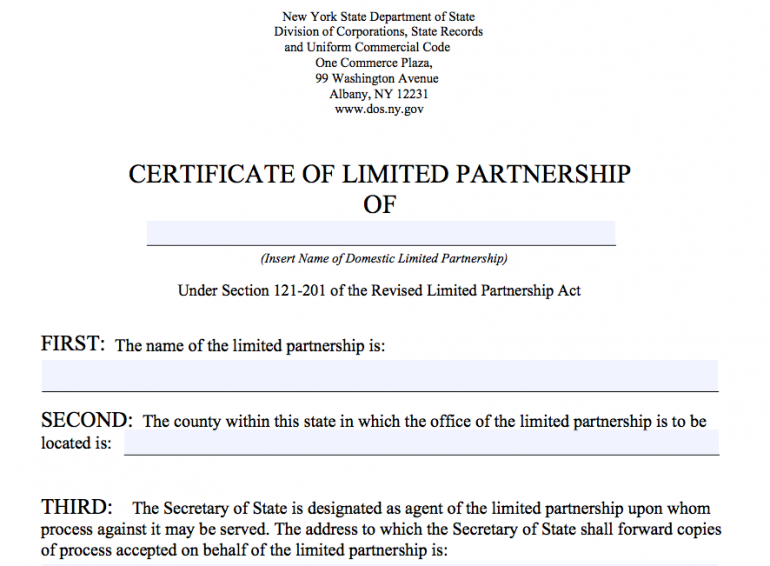Limited Partnership: What Is a Limited Partnership, and How to Form One
Many or all of the products featured here are from our partners who compensate us. This influences which products we write about and where and how the product appears on a page. However, this does not influence our evaluations. Our opinions are our own. Here is a list of our partners and here's how we make money.
FEATURED
How limited partnerships work
A partnership is a business that is owned by two or more individuals, who each contribute something of value to the company, such as money, property, skills or labor. Partners share in the profits and losses of the company. All of this remains true in a limited partnership, but a limited partnership has two different types of partners: general and limited partners.
General partners participate in the day-to-day management of the business. Each general partner faces full personal liability for the debts, obligations and activities of the partnership. This means if someone has a legal claim against the partnership, they can sue any or all general partners. They can even lay claim to the general partners’ personal assets if the business assets of the partnership aren’t sufficient.
As their name suggests, limited partners play a much more limited role in the business. Limited partners are often called “passive investors” or “silent partners.” They typically contribute money to the business and share in the income stream of the business. However, they don’t participate in the day-to-day management of the company. And like shareholders in a corporation, limited partners are only liable for business debts and obligations up to the extent of their investment in the company. In other words, if a limited partner invests $1 million in the business, that’s the maximum they can be personally accountable for in a lawsuit against the company.
When are limited partnerships useful?
Limited partnerships are not as popular among small-business owners as some other business entity types, especially LLCs and S-corporations. However, there are special instances in which they are common.
Here are some situations where limited partnerships are common:
Family businesses: Many family-owned businesses designate one or two members of the family as general partners with management responsibility. The other family members are limited partners, sharing only in the income of the business. Eventually, management responsibility passes on to younger family members who inherit the business. This is sometimes called a family limited partnership.
Commercial real estate projects: A limited partner often fronts money for large commercial real estate projects, such as shopping malls and apartment complexes. The limited partner receives financial benefit from the income generated by the project, but they designate a general partner to oversee the completion of the project itself.
Professional businesses: In professional industries, such as doctor’s offices and law firms, older, retiring members might wish to stay involved as limited partners. They’ll cede management control of the company to general partners.
Estate planning: A limited partnership can be used as an estate planning tool, where the general partner holds real estate on behalf of the heir. The asset produces an income stream for the heir, who will eventually hold the real estate in their own right.
In the examples mentioned above, the ability to pool the resources of general and limited partners can be critical to getting the business off the ground. General partners bring skills and labor to the table, while limited partners bring financial resources.
Even Warren Buffet started out with a limited partnership called Buffet Associates Ltd. The company included seven of his family members and friends. Buffet was the general partner and put in just $100 of his own money. His family and friends were limited partners and contributed a sizable initial investment. With his investing prowess, Buffet grew the group’s initial investment of $105,000 to $105 million in assets within 13 years!
Limited partnership taxes
Limited partnerships are pretty similar to general partnerships when it comes to taxes. A limited partnership is a pass-through entity, which means the partnership itself doesn’t pay taxes in the way a corporation would. The partnership fills out Form 1065 as an informational return and provides a Schedule K-1 to each partner with details of the partner’s share of the company’s income and losses. Using the Schedule K-1, each partner then reports their share of the business income and losses on their personal tax return. The income is taxed at the owner’s personal income tax rate.
If business losses are greater than profits, partners in a limited partnership can deduct losses up to their investment in the businesses. If their losses are greater than their investments, they can carry the losses to other years to offset the profitability of those years. But since limited partners don’t participate in the management of the business, their income is called passive income or loss. Passive income or losses can only offset other passive income.
One tax advantage of limited partnerships is that only general partners have to pay self-employment taxes on their earnings from the company. Self-employment taxes cover Social Security and Medicare taxes. Limited partners don’t have to pay self-employment taxes (except on guaranteed payments received for services provided to the partnership) because they don’t participate in the day-to-day management of the business.
Limited partnership compliance
Since limited partnerships have investors, they are subject to many of the same securities laws as corporations. Issuing ownership shares in a limited partnership, called limited partnership units, is similar to issuing stock in an S-corporation or C-corporation. Just like corporations, limited partnerships must hold investor meetings and allow all partners access to business books and financial records. Some states even require limited partnerships to publish an annual report.
The best rule of thumb is to understand your state’s laws and requirements as well as possible. Every state, except Louisiana, has enacted some version of the Uniform Limited Partnership Act.
Other types of partnerships
There are several different kinds of partnerships. The main thing partnerships have in common is that multiple people own the business, and they all share in the profits and losses of the business. However, each type of partnership is very different in terms of management structure and the division of resources and liability. Limited partnerships have two kinds of partners: general and limited partners. General partners are exposed to personal liability, but manage the business on a daily basis. Limited partners invest money in the business and are shielded from personal liability beyond the amount of their investments. However, limited partners don’t participate in daily management of the company.
General partnership
A general partnership is one of the simplest types of business entities to start. In fact, if you start a business with multiple owners and don’t register your company with the state, your business is a general partnership by default.
In a general partnership, all the owners share in the management responsibilities, profits and losses. Each owner is also fully personally liable for the debts and obligations of the business. Each partner owes fiduciary duties of loyalty, care and good faith to the partnership and other partners.
Joint venture
A joint venture is a temporary general partnership that two or more people or companies start for a particular purpose. Usually, a joint venture expires when the project is completed or on a specific date, so it is more limited in scope than a general partnership.
Similar to a general partnership, the parties to a joint venture are personally liable for the debts and obligations of the business and owe a fiduciary duty to one another. A joint venture might also be launched as a separate LLC or corporate entity, in which case partnership rules wouldn’t apply.
Limited liability partnership
A limited liability partnership (LLP) has no general partners. In this type of business, all partners have limited personal liability for the debts and obligations of the business. LLPs are popular among professionals, like doctors and architects. In fact, in some states, the LLP structure is only available to professionals. Professionals like to form LLPS so that they can actively participate in the business but aren’t personally liable for malpractice claims filed against their colleagues.
Limited liability limited partnership
There is yet another type of partnership called limited liability limited partnership (LLLP) that’s only recognized in some states. An LLLP is similar to a limited partnership because it has general and limited partners. However, the big difference is that the general partners have limited personal liability for the partnership’s debts and obligations. That means if the partnership is sued, all partners are responsible only up to the amount of their investment. LLLPs are popular among groups of real estate developers, who seek to limit their exposure to what they’ve invested in a project.
Pros and cons
It’s best to get the help of a business attorney and tax professional when making this decision, but these are some pros and cons to consider.
Pros
Pool resources: This structure allows you to pool the financial resources of limited partners, combined with the skills and labor of general partners.
Limited liability for limited partners: Limited partners can’t face liability beyond what they invest in the business.
General partners are independent: General partners can make management decisions, without having to consult limited partners.
Easy transitions: Limited partners can easily exit the business without causing management problems.
Simple tax filing: Limited partnerships have simple pass-through tax filing, where each partner reports their share of the business income and losses on their personal tax return.
Works for some business types: Certain types of businesses, like family-owned businesses and real estate companies, prefer limited partnerships.
Cons
General partners face more liability: General partners face maximum personal exposure for business debts and obligations.
No say for limited partners: Limited partners have no say in business decisions, which can cause tension among partners.
More paperwork: Limited partnerships require more paperwork and compliance than a general partnership.
In most cases, forming a limited partnership comes down to resource constraints and practicality. Someone might have a great business idea and the skills to make that idea a reality, but lack the cash to get started. If that person can find a limited partner to front the cash in exchange for a portion of the business profits, then a limited partnership is born. The limited partner is shielded from liability, and the general partner agrees to take on more risk.

Source: New York Department of State
How to form a limited partnership
If you decide that you want to form a limited partnership, then you’ll have to file a certificate of limited partnership with your state’s secretary of state office. The certificate of limited partnership contains the following basic information about your company:
Name of the business (typically must end in “Limited” or “Ltd.”).
Registered agent of the business who will accept legal documents on the business’s behalf.
Name and address of each general partner.
Signature of general partner or person filling out the form.
Shortly after filing your Certificate of Limited Partnership, you and your partners should draft a partnership agreement. An agreement is not legally required, and it’s not filed with the state. Nonetheless, a partnership agreement is a very important document because it provides a blueprint for operating your business. The agreement lays out the rights and responsibilities of each partner, stemming conflicts in the future.
Business owners who want some help in filing their Certificate of Limited Partnership might want to try a service like LegalZoom. LegalZoom has a step-by-step questionnaire to make filing the form a breeze. It will also help you create a custom partnership agreement.
A version of this article was first published on Fundera, a subsidiary of NerdWallet.


